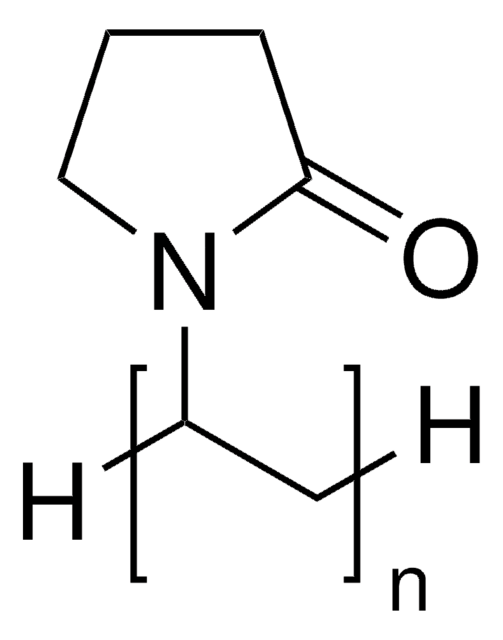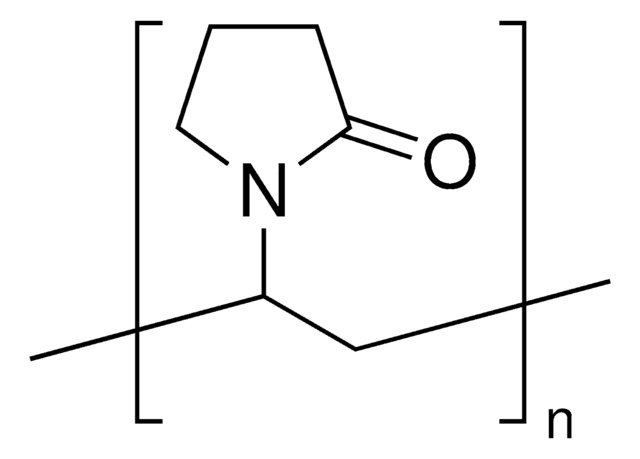90268
Polyvinylpyrrolidone
K 25, tested according to Ph. Eur.
Synonym(s):
PVP, Polyvidone, Povidone
Sign Into View Organizational & Contract Pricing
All Photos(1)
About This Item
Recommended Products
agency
tested according to Ph. Eur.
Quality Level
form
powder
SMILES string
C=CN1CCCC1=O
InChI
1S/C6H9NO/c1-2-7-5-3-4-6(7)8/h2H,1,3-5H2
InChI key
WHNWPMSKXPGLAX-UHFFFAOYSA-N
Looking for similar products? Visit Product Comparison Guide
Application
- Colyophilized Sugar-Polymer Dispersions for Enhanced Processing and Storage Stability.: This study explores the use of polyvinylpyrrolidone in colyophilized sugar-polymer dispersions to improve the processing and storage stability of pharmaceuticals. The research demonstrates how combining sugars with polyvinylpyrrolidone enhances the physical stability and performance of the resulting dispersions, which is crucial for maintaining drug efficacy during storage and handling (Giannachi et al., 2024).
- Fabrication and evaluation of stable amorphous polymer-drug composite particles via a nozzle-free ultrasonic nebulizer.: This article discusses the development of amorphous polymer-drug composite particles using polyvinylpyrrolidone and a nozzle-free ultrasonic nebulizer. The findings indicate that polyvinylpyrrolidone helps in stabilizing the amorphous form of the drug, which can enhance its solubility and bioavailability (Lee et al., 2024).
- Polymer-Assisted Coprecipitation Synthesized Zinc Oxide Nanoparticles and Their Uses for Gre en Chemical Synthesis via Photocatalytic Glucose Conversions.: This study presents a novel method of using polyvinylpyrrolidone in the synthesis of zinc oxide nanoparticles. The research shows that these nanoparticles can be used in green chemical processes, such as the photocatalytic conversion of glucose, showcasing the versatility of polyvinylpyrrolidone in catalysis and material science (Kaewsaenee et al., 2023).
- Development and evaluation of the in vitro schistosomicidal activity of solid dispersions based on 2-(-5-bromo-1-H-indole-3-yl-methylene)-N-(naphthalene-1-ylhydrazine-carbothiamide).: This article explores the use of polyvinylpyrrolidone in formulating solid dispersions for antiparasitic treatments. The findings demonstrate that polyvinylpyrrolidone can enhance the solubility and efficacy of the active pharmaceutical ingredient against parasitic infections (de Luna Rocha et al., 2024).
Other Notes
Polyvinylpyrrolidone is a component of Denhardt′s Solution and is included at a concentration of 1% (w/v) in the standard 50X stock solution.
wgk_germany
WGK 1
flash_point_f
Not applicable
flash_point_c
Not applicable
Choose from one of the most recent versions:
Already Own This Product?
Find documentation for the products that you have recently purchased in the Document Library.
Customers Also Viewed
Jennifer Quirós et al.
Journal of hazardous materials, 299, 298-305 (2015-07-05)
The use of electrospun polyvinylpyrrolidone (PVP) nanofibers containing silver, copper, and zinc nanoparticles was studied to prepare antimicrobial mats using silver and copper nitrates and zinc acetate as precursors. Silver became reduced during electrospinning and formed nanoparticles of several tens
Na0.44 MnO2 with very fast sodium diffusion and stable cycling synthesized via polyvinylpyrrolidone-combustion method.
Dai K, et al.
Journal of Power Sources, 285, 161-168 (2015)
Kallum M Koczkur et al.
Dalton transactions (Cambridge, England : 2003), 44(41), 17883-17905 (2015-10-06)
Colloidal synthesis offers a route to nanoparticles (NPs) with controlled composition and structural features. This Perspective describes the use of polyvinylpyrrolidone (PVP) to obtain such nanostructures. PVP can serve as a surface stabilizer, growth modifier, nanoparticle dispersant, and reducing agent.
Doris Bach et al.
Journal of photochemistry and photobiology. B, Biology, 120, 74-81 (2013-03-08)
Photodynamic therapy (PDT) is a local tumour treatment accepted for a number of indications. PDT operates via the cellular stress response through the production of reactive oxygen species and subsequent cellular damage, resulting in cell death. Although PDT-induced signalling and
S Fardindoost et al.
Nanotechnology, 24(13), 135201-135201 (2013-03-13)
In this paper we present experimental results describing electrical readout of the mechanical vibratory response of graphene-doped fibers by employing electrical actuation. For a fiber resonator with an approximate radius of 850 nm and length of 100 μm, we observed a resonance
Our team of scientists has experience in all areas of research including Life Science, Material Science, Chemical Synthesis, Chromatography, Analytical and many others.
Contact Technical Service
